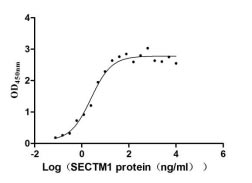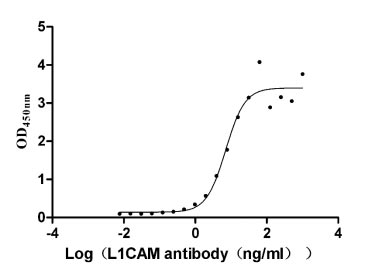Recombinant Rat Prolactin receptor (Prlr)
-
中文名称:大鼠Prlr重组蛋白
-
货号:CSB-CF018727RA
-
规格:
-
来源:in vitro E.coli expression system
-
其他:
产品详情
-
基因名:
-
Uniprot No.:
-
别名:Prlr; Prolactin receptor; PRL-R; Lactogen receptor
-
种属:Rattus norvegicus (Rat)
-
蛋白长度:Full Length of Mature Protein
-
表达区域:20-610
-
氨基酸序列QSPPGKPEIHKCRSPDKETFTCWWNPGTDGGLPTNYSLTYSKEGEKTTYECPDYKTSGPNSCFFSKQYTSIWKIYIITVNATNQMGSSSSDPLYVDVTYIVEPEPPRNLTLEVKQLKDKKTYLWVKWSPPTITDVKTGWFTMEYEIRLKPEEAEEWEIHFTGHQTQFKVFDLYPGQKYLVQTRCKPDHGYWSRWSQESSVEMPNDFTLKDTTVWIIVAILSAVICLIMVWAVALKGYSMMTCIFPPVPGPKIKGFDTHLLEKGKSEELLSALGCQDFPPTSDCEDLLVEFLEVDDNEDERLMPSHSKEYPGQGVKPTHLDPDSDSGHGSYDSHSLLSEKCEEPQAYPPTLHIPEITEKPENPEANIPPTVDPQSTNPNFHVDAPKSSTWPLLPGQHMPRSPYHSVADVCKLAGSPVNTLDSFLDKAEENVLKLSKALETGEEEVAEQKGAKSFPSDKQNTPWPLLQEKSPTVYVKPPDYVEIHKVNKDGVLSLFPKQRENNQTEKPGVPETSKEYAKVSGITDNNILVLVPDSRAQNTALLEESAKKAPPSFEADQSEKDLASFTATSSNRRLQLGRLDYLDPTCFMHSFH
Note: The complete sequence including tag sequence, target protein sequence and linker sequence could be provided upon request. -
蛋白标签:N-terminal 10xHis-tagged
-
产品提供形式:Liquid or Lyophilized powder
Note: We will preferentially ship the format that we have in stock, however, if you have any special requirement for the format, please remark your requirement when placing the order, we will prepare according to your demand. -
缓冲液:Lyophilized from Tris/PBS-based buffer, 6% Trehalose, pH 8.0
-
储存条件:Store at -20°C/-80°C upon receipt, aliquoting is necessary for mutiple use. Avoid repeated freeze-thaw cycles.
-
保质期:The shelf life is related to many factors, storage state, buffer ingredients, storage temperature and the stability of the protein itself.
Generally, the shelf life of liquid form is 6 months at -20°C/-80°C. The shelf life of lyophilized form is 12 months at -20°C/-80°C. -
货期:Basically, we can dispatch the products out in 1-3 working days after receiving your orders. Delivery time may differ from different purchasing way or location, please kindly consult your local distributors for specific delivery time.Note: All of our proteins are default shipped with normal blue ice packs, if you request to ship with dry ice, please communicate with us in advance and extra fees will be charged.
-
注意事项:Repeated freezing and thawing is not recommended. Store working aliquots at 4°C for up to one week.
-
Datasheet & COA:Please contact us to get it.
相关产品
靶点详情
-
功能:This is a receptor for the anterior pituitary hormone prolactin.
-
基因功能参考文献:
- PRLR signaling is required for DNA synthesis and survival of rat insulinoma cells PMID: 24114406
- The cholestasis-induced changes in the intensity of prolactin receptor expression were opposite in kidney and liver cells. PMID: 22977841
- The results demonstrate that the prolactin receptor system is altered in nonneural tissues as a result of the female's reproductive history. PMID: 21508351
- PRLR mRNA was highly expressed throughout the rostral preoptic area, particularly in periventricular regions surrounding the third ventricle, and there was a high degree of colocalization of PRLR mRNA in both Gad1/Gad2 and Kiss1 mRNA-containing cells. PMID: 21177834
- Report cross talk between prolactin and dopamine 1-like receptors in renal proximal tubular cells. PMID: 20462969
- binding sites for various lactogenic hormones are localized PMID: 11735251
- The expression of both forms of prolactin receptor mRNA in nigrostriatal areas may help to support the hypothesis that prolactin has direct actions on these brain regions PMID: 11835322
- The ratio of prolactin receptor isoforms in rat hepatocytes:the effect of obstructive cholestasis PMID: 11862718
- prolactin receptor gene expression in rat brain is controlled by the promoter for the E1(4) first exon PMID: 12021172
- Sex difference and estrous cycle: expression of prolactin receptor mRNA in rat brain. PMID: 12106698
- Estrogen differentially regulates expression of the PRL-R mRNA in the different brain regions by increasing the utilization of PRL-R gene promoters 1A and 1C in the female rat. PMID: 12673052
- results demonstrate that prostaglandin F2alpha inhibits the expression of the prolactin receptor PMID: 12865306
- time-course of changes in PRL-R mRNA levels during pregnancy and/or lactation, and determination of relative levels of the two forms (short and/or long form) of receptor mRNA in specific brain regions PMID: 12914538
- PRLR mediates the inhibition of restraint stress in water (RSW)-induced hypocalcemia and gastric erosion, as seen in gene deletion. PMID: 15845620
- Level of expression in the preoptic area is determined by addition of progesterone and estradiol mimicking pregnancy. PMID: 16107292
- the loss of responsiveness to prolactin occurring during lactation is not due to down regulation of long-form PRL-R gene expression on tuberoinfundibular neurones PMID: 16280030
- Obstructive cholestasis sex-independently induces an increase in the long PrlR isoform level and leads to appearance of the short isoform in cholangiocytes. PMID: 16489923
- Hypoxia ischemia induces a robust activation of the prolactin receptor in regions of the cerebral cortex affected by injury. PMID: 17317019
- The expression of prolactin receptor in the paraventricular nucleus may be important in suppressing gastric ulceration. PMID: 17322574
- We conclude that PRL inhibits lipolysis and leptin release by acting directly on adipocytes via interaction with either of its receptors and activation of a Jak2-dependent signaling pathway(s). PMID: 17433256
- Region-specific promoter usage in prolactin receptor mRNA transcription, and involvement of oestrogens in the regulation of Exon1-3 mRNA expression in the brain and pituitary gland. PMID: 17620100
- residual agonism can be abolished either by further disrupting hormone site 2-receptor contacts by N-terminal deletion, as in Del1-9-G129R-human prolactin (hPRL), or by stabilizing hPRL and constraining its intrinsic flexibility, as in G129V-hPRL PMID: 17785459
- Expression of PRLR gene in the female and male rat brains increases during postnatal development due to the transcriptional activation of the E1(4) first exon. PMID: 18092198
- Results show that metyrapone-induced corticosterone deficiency impairs Leydig cell insulin and prolactin, but not LH, receptors, and their mRNA expression and the response of Leydig cells to LH/PRL/insulin on testosterone production. PMID: 18313837
- Hypergravity-induced downregulation of prolactin receptor (PRLR) is not directly triggered by deranged distribution of PRLR isoforms. PMID: 18372733
- Lipogenesis impaired in periparturient rats exposed to altered gravity is independent of prolactin and glucocorticoid secretion. PMID: 18665386
- These observations suggest that macrophage functions are regulated by an endogenous dopaminergic tone. Our data also suggest that both PRL and dopamine exert their action by acting directly on the peritoneal macrophage. PMID: 18679052
- Expression of Prlr increases at night in the rat pineal gland ~10-fold. PMID: 19103603
显示更多
收起更多
-
亚细胞定位:Membrane; Single-pass type I membrane protein.
-
蛋白家族:Type I cytokine receptor family, Type 1 subfamily
-
数据库链接:
KEGG: rno:24684
STRING: 10116.ENSRNOP00000056718
UniGene: Rn.9757
Most popular with customers
-
Recombinant Human Secreted and transmembrane protein 1 (SECTM1), partial (Active)
Express system: Mammalian cell
Species: Homo sapiens (Human)
-
Recombinant Human Neural cell adhesion molecule L1 (L1CAM), partial (Active)
Express system: Mammalian cell
Species: Homo sapiens (Human)
-
Recombinant Human 5'-nucleotidase (NT5E) (Active)
Express system: Mammalian cell
Species: Homo sapiens (Human)
-
Recombinant Mouse Prolactin receptor (Prlr), partial (Active)
Express system: Mammalian cell
Species: Mus musculus (Mouse)
-
Recombinant Human Zymogen granule protein 16 homolog B (ZG16B) (Active)
Express system: Mammalian cell
Species: Homo sapiens (Human)
-
Recombinant Human Myosin regulatory light polypeptide 9 (MYL9) (Active)
Express system: Yeast
Species: Homo sapiens (Human)
-
Recombinant Human Oncostatin-M (OSM), partial (Active)
Express system: Mammalian cell
Species: Homo sapiens (Human)
-
Recombinant Human Transmembrane 4 L6 family member 1(TM4SF1)-VLPs (Active)
Express system: Mammalian cell
Species: Homo sapiens (Human)




















